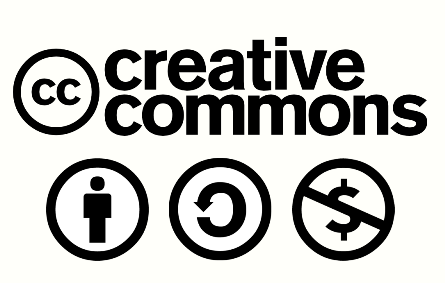Creative Commons
How to Use Creative Commons Licenses/Video Tutorial
···············································································
Creatively Free via Creative Commons
Frequently Asked Questions About CC Licensing
🌎
GreenPolicy360 Supports the Use of Creative Commons licensing for networking and sharing
- GreenPolicy 360: An eco Operating System (eOS)
- ·············································
Origins of Creative Commons
A System for Sharing Legally & Openly
Parker Higgins @xor ... Parker Higgins tweeted
Lawrence Lessig, launching Creative Commons, 16 Dec 2002 http://archive.oreilly.com/pub/a/policy/2003/01/03/cc.html …
Parker Higgins, "Our tradition is freedom, not control; creativity is built on top of freedom, not control. The ideology of control must end now."
How to Use Creative Commons Licenses / YouTube Video Tutorial
Returning Creativity to the Commons
by Richard Koman
- 01/03/2003
- Courtesy of O'Reilly Policy DevCenter -- http://archive.oreilly.com/policy/
It was Eldred reunion night Dec. 16 at the SomArts performance space in San Francisco's South of Market district to celebrate the rollout of Lawrence Lessig's Creative Commons organization. There was Net radical John Gilmore furtively handing out little LED key-chain lights in an array of colors--of course, John wasn't at the Eldred hearing because he only flies anonymously, which is to say he doesn't fly at all. EFF provacateur Cory Doctorow was there sporting a slimmer frame courtesy of the Atkins diet and a new EFF bumpersticker. Creative Commons' XML maven Lisa Rein was buzzing excitedly about the outlook for the Elcomsoft trial (they were acquitted the next day). And there was Brewster Kahle and the Internet Bookmobile, parked right on the floor of the space, just below a trippy computer projection slide show and not too far from the grilled eggplant and hummus table, handing out yet more copies of Alice in Wonderland, made on the spot thanks to the amazing desktop binding machine. Oh, and Eric Eldred himself was there, unassuming in a Red Sox baseball cap.
When the program itself started, Eldred attorney Lawrence Lessig took the stage and did what he does so well in his public speeches--boiling complex issues down to their essence, sometimes a one- or two-word essence. This boiling down is underlined by his slides, writing large the juxtaposition of two opposing themes. He starts with a story of his father complaining about someone who owes him money and the young Larry innocently asks, "Dad, why don't you sue him?" The elder Lessig gives a stern look and tells his son, "Son, in this world there are those who do"; cues a black slide with the Courier-set word "do"; "and those who sue"; cue the "sue" slide. "Those who tear down and those who build"; cue the "build" slide...
The genesis for Creative Commons came from Eldred himself, who told Lessig in an early meeting on the case that he didn't even care if they won the case; "what I care about," Lessig reports Eldred saying, "is that we build something that increases the public domain." That's Creative Commons, a series of projects designed to increase the amount of "stuff available to others."
Creative Commons is trying to build, or rebuild, the enabling of the public domain. It starts with two efforts, both of which allow creators to say, "I want to be compensated (perhaps financially or perhaps just with credit) for my work, and I want to enrich the public domain with my works."
These two efforts are:
The Creative Commons license, which includes "legal code" (assuring creators that the rights they assert will be legally protected), a "commons deed," (a simple statement of which rights are asserted and which are ceded, which anyone can understand), and "machine-readable code," (some metadata in the form of RDF, so that computer programs can understand the terms of the work.)
The Founders Copyright, under which publishers and creators agree to limit their copyright protections to 14 years, renewable to 28 years. (O'Reilly & Associates has pledged to convert some 200 works to Founders Copyright within the next month)...
Lessig talks about creative works having two lives. First, there is the private, commercial life, during which money is charged and, perhaps, profits are made. Then there is a second life, a noncommercial life, when the work is turned over to the public domain. It's not a new idea; surely this was the framers' vision.
"Think of it as recycling," Tim O'Reilly tells me after the presentations, while technical difficulties delayed DJ Spooky's real-time remixing of Birth of a Nation. "It's a code of conduct for the digital age: recycle stuff when you're done with it .... Keeping under copyright something that no longer has value is like keeping all your old newspapers .... It's about small opportunities. You never know what people will do with something you're not using."
···············
The Creative Commons license lets you specify that your work can be freely copied with any or none of several restrictions. To create a license, visit the Creative Commons site and answer these three questions:
Do you want to require attribution?
Do you want to allow commercial uses?
Do you want to allow derivative works?
Based on these choices, Creative Commons' software pulls up the appropriate license and provides an image and text that you can place on a Web site or include in printed material. You can post the commons deed (a simple statement of license) on your Web site and link to the legal document. Creative Commons also provides code for you to link to their RDF for your license. Creative Common's RDF includes the following:
- title
- description
- subject
- publisher
- creator
- contributor
- rights
- date
- format
- type
- source, derivative work
- license
As long as this information is linked from your document, other computers (with RDF-reading ability) accessing the document will know the rights and permissions. This is crucial as the Web moves from the computer-to-human paradigm to the computer-to-computer paradigm.
What's next? Look for the ability to add more metadata to your creations, and the integration of Creative Commons metadata into search engines like Google.
○
